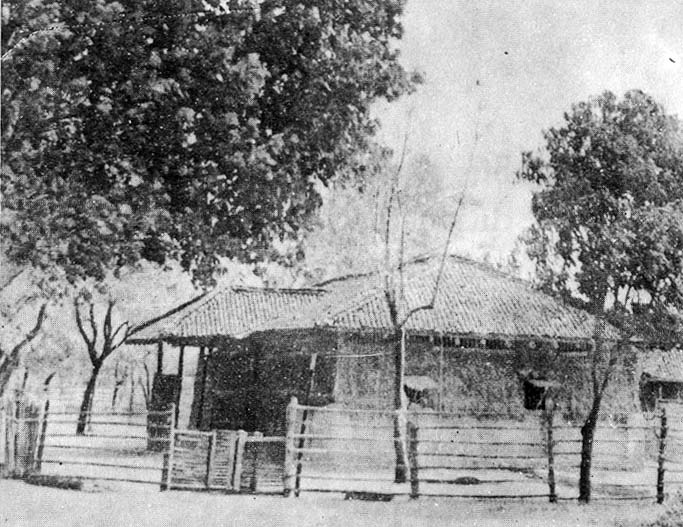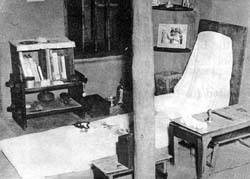
Some men changed their times...
One man changed the World for all times!
Comprehensive Website on the life and works of
Mahatma Gandhi
+91-23872061
+91-9022483828
info@mkgandhi.org

+91-23872061
+91-9022483828
info@mkgandhi.org
21. Sevagram |
 Gandhi's Hut at Sevagram At home Gandhi found that the Government had returned to the policy of repression. There were widespread arrests and the Government seized the properties and bank balances of people and organizations who were hostile to their interests. Early in 1932 Gandhi wanted to meet the new Viceroy, Lord Willingdon, but the Viceroy made it clear that the days of negotiation were over. Gandhi informed the authorities that he was again starting a civil disobedience campaign. The Viceroy thought it was a threat. He had Gandhi arrested and imprisoned in Yeravda Central Jail. Several other leaders and many of Gandhi's followers were also arrested and sent to jail. In March the struggle entered a new phase. Gandhi had always insisted that the untouchables were a part of the Hindus and must be treated as Hindus. Now, however, it was announced that the British proposed to set up separate voting for the untouchables. That meant that untouchables could vote only members of their own caste. Gandhi regarded the Hindu religion as one and indivisible. He saw the game the British were playing. It was an attempt to weaken Hindu society. 'Separate treatment of untouchables cannot be allowed,' declared Gandhi. 'Here is an attempt to make unsociability last for ever. Unless unsociability is destroyed we can never have self-government.' 'But what can you do about this election law now?' asked a friend. 'I can die,' was his proper answer. 'I will resist this evil provision with my life. Gandhi announced that he would soon start a fast unto death unless the plan for separate electorates was changed. The public announcement of his intention threw the country into panic. The Indian leaders were shocked at Gandhi's decision. Even Jawaharlal Nehru thought that he was taking a drastic step on a side issue. During the time between the announcement and the day when Gandhi's fast was to begin, streams of visitors arrived at Yeravda Jail. The authorities, anxious to avoid any tragedy, allowed everyone to have free access to Gandhi. But all efforts to dissuade Gandhi from fasting were of no avail. The die was cast. Gandhi would fast. Tagore sent him a telegram: 'It is worth sacrificing precious life for the sake of India's unity and her social integrity. Our sorrowing hearts will follow your sublime penance with reverence and love.' Gandhi started his fast on September 20, 1932. The first day of the fast was observed all over India as a day of prayer and fasting. Many temples were opened to untouchables and meetings were held all over India urging the removal of unsociability. Outside the jail political activity boiled. Leaders of caste Hindus and untouchables met and discussed various measures to try to arrive at compromise that would satisfy Gandhi. Proposals were made counter-proposals were made and rejected. Dr. B.R. Ambedkar, the most powerful leader of the untouchables, met Gandhi and assured him that he would try his beat to find a solution which would save Gandhi's life. The fast went on into the third day, and Gandhi's condition caused anxiety to all his friends. He was a very weak and he had to be carried to the bath-room on a stretcher. His voice was feeble. His blood pressure was increasing. The authoritie4s grew panicky. They sent for his wife and they allowed all his friends and followers to be with him. The Indian people felt desperate. Gandhi might die and leave them leaderless. Other political leaders had failed, for they were unable to find a solution which would enable Gandhi to break his fast. Gandhi, however, would not accept this unless it had been ratified by the British. News came that the British had approved the pact; but still Gandhi would not break his fast until he saw the text of the approval. While Gandhi waited for the text to come, Tagore paid him a visit. The poet was so moved by Gandhi's weak condition that he put his head on Gandhi's chest and wept.  Gandhi's room at Sevagram Gandhi was released from prison in 1933. Shortly afterwards he suspended the mass civil disobedience movement, but sanctioned individual civil resistance to the Government's brutal policy. For the next seven years, Gandhi worked hard for the social and spiritual progress of his people. Many leaders, including Jawaharlal Nehru, did not approve of Gandhi's policy. 'But' Nehru said, 'How can I presume to advise a magician?' the 'magician' continued to win Nehru's unstinted devotion. Sabarmati Ashrama had been seized by the Government during the Salt Satyagraha, so Gandhi now established a little retreat at Sevagram near Wardha in Maharashtra. This became his headquarters. New reforms sponsored by the Government got little support from the people of India. However, many people, including Congressmen, wanted to try them out as a means of furthering the cause of Swaraj. |